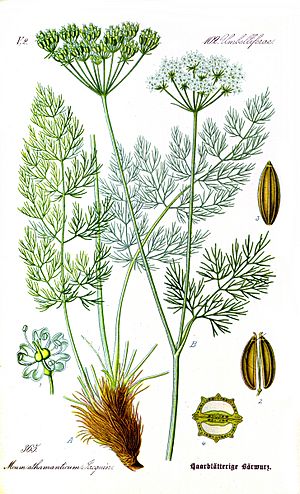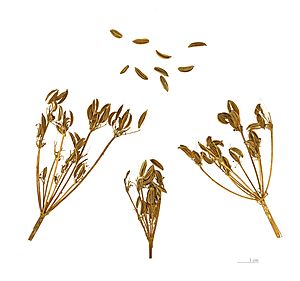Meum athamanticum facts for kids
Quick facts for kids Meum athamanticum |
|
|---|---|
 |
|
| Scientific classification | |
| Kingdom: | |
| (unranked): | |
| (unranked): | |
| (unranked): | |
| Order: | |
| Family: | |
| Genus: | |
| Species: |
M. athamanticum
|
| Binomial name | |
| Meum athamanticum |
|
Meum athamanticum is a special plant known for its strong, pleasant smell. It's often called baldmoney, meu, or spignel in the UK. This plant is the only one of its kind in the Meum group, and it grows back every year. It has smooth leaves and stems, meaning they don't have any hairs.
Contents
Where Baldmoney Grows
This interesting plant usually grows in grassy areas, especially where there's limestone rock. You can find it in the mountains of Western Europe and Central Europe. Its range stretches from the Sierra Nevada (Spain) in southern Spain all the way to central Bulgaria.
It's not very common in the UK. You might find it in a few places in northern England and northern Wales. It's a bit more common in Scotland, growing as far north as Argyll and Aberdeenshire.
Uses of Meum Athamanticum
People have used Meum athamanticum for a long time. In Scotland, the roots were grown and eaten as a root vegetable.
Cooking and Flavor
The plant's delicate, feathery leaves have been used as a condiment. This means they were added to food to give it a special flavor. The smell of Meum roots is similar to other plants like Lovage and Angelica archangelica. The leaves have a taste somewhat like Melilot, which smells like fresh hay. When cows eat Meum leaves in spring, the flavor can even pass into their milk and butter!
Traditional Remedies
People also used Meum athamanticum in many home remedies. It was used as a diuretic, which helps the body get rid of extra water. It was also used to help with certain women's health issues. Other uses included treating catarrh (a runny nose or mucus), strong emotional upset, and stomach problems.
The Name Baldmoney
The unusual name Baldmoney is thought to come from the name of the god Baldr. Baldr is a god from Scandinavian mythology, and the plant was dedicated to him.
In Germany, the plant is called Bärwurz, which means "bear wort". There's also a type of Bavarian schnapps (a strong alcoholic drink) that gets its flavor from this plant.
See also
 In Spanish: Meum athamanticum para niños
In Spanish: Meum athamanticum para niños


